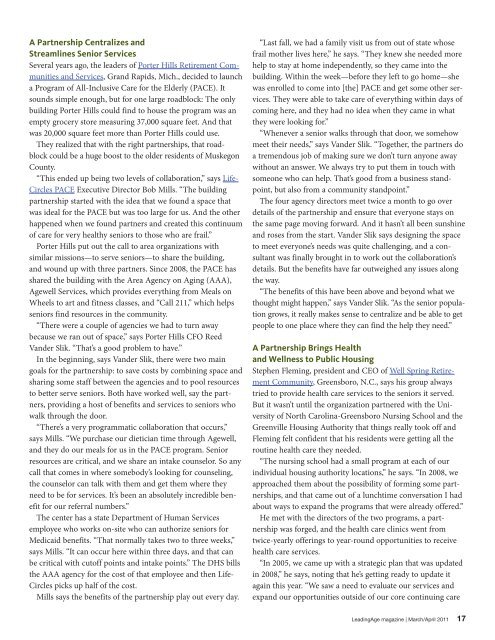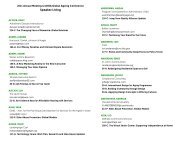The Anatomy of Change The Anatomy of Change - LeadingAge
The Anatomy of Change The Anatomy of Change - LeadingAge
The Anatomy of Change The Anatomy of Change - LeadingAge
Create successful ePaper yourself
Turn your PDF publications into a flip-book with our unique Google optimized e-Paper software.
A Partnership Centralizes and<br />
Streamlines Senior Services<br />
Several years ago, the leaders <strong>of</strong> Porter Hills Retirement Communities<br />
and Services, Grand Rapids, Mich., decided to launch<br />
a Program <strong>of</strong> All-Inclusive Care for the Elderly (PACE). It<br />
sounds simple enough, but for one large roadblock: <strong>The</strong> only<br />
building Porter Hills could find to house the program was an<br />
empty grocery store measuring 37,000 square feet. And that<br />
was 20,000 square feet more than Porter Hills could use.<br />
<strong>The</strong>y realized that with the right partnerships, that roadblock<br />
could be a huge boost to the older residents <strong>of</strong> Muskegon<br />
County.<br />
“This ended up being two levels <strong>of</strong> collaboration,” says Life-<br />
Circles PACE Executive Director Bob Mills. “<strong>The</strong> building<br />
partnership started with the idea that we found a space that<br />
was ideal for the PACE but was too large for us. And the other<br />
happened when we found partners and created this continuum<br />
<strong>of</strong> care for very healthy seniors to those who are frail.”<br />
Porter Hills put out the call to area organizations with<br />
similar missions—to serve seniors—to share the building,<br />
and wound up with three partners. Since 2008, the PACE has<br />
shared the building with the Area Agency on Aging (AAA),<br />
Agewell Services, which provides everything from Meals on<br />
Wheels to art and fitness classes, and “Call 211,” which helps<br />
seniors find resources in the community.<br />
“<strong>The</strong>re were a couple <strong>of</strong> agencies we had to turn away<br />
because we ran out <strong>of</strong> space,” says Porter Hills CFO Reed<br />
Vander Slik. “That’s a good problem to have.”<br />
In the beginning, says Vander Slik, there were two main<br />
goals for the partnership: to save costs by combining space and<br />
sharing some staff between the agencies and to pool resources<br />
to better serve seniors. Both have worked well, say the partners,<br />
providing a host <strong>of</strong> benefits and services to seniors who<br />
walk through the door.<br />
“<strong>The</strong>re’s a very programmatic collaboration that occurs,”<br />
says Mills. “We purchase our dietician time through Agewell,<br />
and they do our meals for us in the PACE program. Senior<br />
resources are critical, and we share an intake counselor. So any<br />
call that comes in where somebody’s looking for counseling,<br />
the counselor can talk with them and get them where they<br />
need to be for services. It’s been an absolutely incredible benefit<br />
for our referral numbers.”<br />
<strong>The</strong> center has a state Department <strong>of</strong> Human Services<br />
employee who works on-site who can authorize seniors for<br />
Medicaid benefits. “That normally takes two to three weeks,”<br />
says Mills. “It can occur here within three days, and that can<br />
be critical with cut<strong>of</strong>f points and intake points.” <strong>The</strong> DHS bills<br />
the AAA agency for the cost <strong>of</strong> that employee and then Life-<br />
Circles picks up half <strong>of</strong> the cost.<br />
Mills says the benefits <strong>of</strong> the partnership play out every day.<br />
“Last fall, we had a family visit us from out <strong>of</strong> state whose<br />
frail mother lives here,” he says. “<strong>The</strong>y knew she needed more<br />
help to stay at home independently, so they came into the<br />
building. Within the week—before they left to go home—she<br />
was enrolled to come into [the] PACE and get some other services.<br />
<strong>The</strong>y were able to take care <strong>of</strong> everything within days <strong>of</strong><br />
coming here, and they had no idea when they came in what<br />
they were looking for.”<br />
“Whenever a senior walks through that door, we somehow<br />
meet their needs,” says Vander Slik. “Together, the partners do<br />
a tremendous job <strong>of</strong> making sure we don’t turn anyone away<br />
without an answer. We always try to put them in touch with<br />
someone who can help. That’s good from a business standpoint,<br />
but also from a community standpoint.”<br />
<strong>The</strong> four agency directors meet twice a month to go over<br />
details <strong>of</strong> the partnership and ensure that everyone stays on<br />
the same page moving forward. And it hasn’t all been sunshine<br />
and roses from the start. Vander Slik says designing the space<br />
to meet everyone’s needs was quite challenging, and a consultant<br />
was finally brought in to work out the collaboration’s<br />
details. But the benefits have far outweighed any issues along<br />
the way.<br />
“<strong>The</strong> benefits <strong>of</strong> this have been above and beyond what we<br />
thought might happen,” says Vander Slik. “As the senior population<br />
grows, it really makes sense to centralize and be able to get<br />
people to one place where they can find the help they need.”<br />
A Partnership Brings Health<br />
and Wellness to Public Housing<br />
Stephen Fleming, president and CEO <strong>of</strong> Well Spring Retirement<br />
Community, Greensboro, N.C., says his group always<br />
tried to provide health care services to the seniors it served.<br />
But it wasn’t until the organization partnered with the University<br />
<strong>of</strong> North Carolina-Greensboro Nursing School and the<br />
Greenville Housing Authority that things really took <strong>of</strong>f and<br />
Fleming felt confident that his residents were getting all the<br />
routine health care they needed.<br />
“<strong>The</strong> nursing school had a small program at each <strong>of</strong> our<br />
individual housing authority locations,” he says. “In 2008, we<br />
approached them about the possibility <strong>of</strong> forming some partnerships,<br />
and that came out <strong>of</strong> a lunchtime conversation I had<br />
about ways to expand the programs that were already <strong>of</strong>fered.”<br />
He met with the directors <strong>of</strong> the two programs, a partnership<br />
was forged, and the health care clinics went from<br />
twice-yearly <strong>of</strong>ferings to year-round opportunities to receive<br />
health care services.<br />
“In 2005, we came up with a strategic plan that was updated<br />
in 2008,” he says, noting that he’s getting ready to update it<br />
again this year. “We saw a need to evaluate our services and<br />
expand our opportunities outside <strong>of</strong> our core continuing care<br />
<strong>LeadingAge</strong> magazine | March/April 2011 17



